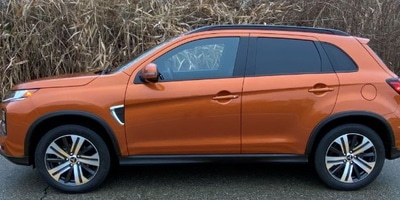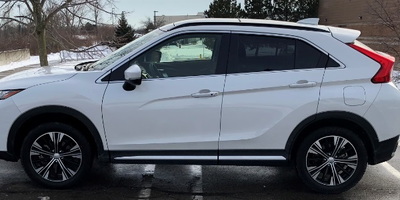An attractive entry-level price and a smooth ride can't make up for a number of shortcomings in Mitsubishi's entry in the compact crossover segment.
Pros:
Smooth ride
Seating position
Improved audio display
Cons:
Cheap, dull interior trim
Only adequate acceleration
Road noise
2017 Outlander Sport
The Outlander Sport is Mitsubishi's best-selling vehicle, accounting for 28 percent of the brand’s sales in 2016. That figure is down from 38 percent in 2014, but you can probably chalk it up to the fact that, other than a mild refresh in 2016, little else has been done to it since it was introduced in 2010 as a 2011 model.
As we'll see, in the hot vehicle segments such as the compact crossover, treading water is not an option if you want to keep up with the competition.
Exterior
For the 2016 model year, the Outlander Sport received a minor facelift. With the demise of the Lancer Evolution X, Mitsubishi decided to eighty-six the Sport's Evo-inspired "shark nose." It was replaced by what Mitsubishi calls its new "Dynamic Shield" grille. It boasts a few more chrome bits and more right angles but, at least in our opinion, hardly sets the Outlander Sport apart from a very crowded field of competitors.
Aside from that tweak, little else has changed from the last time we drove one, which was back in 2014. The sides remain plain with a pair of mildly flared wheel wells, a single upper character line and a mildly scooped lower character line. Sprucing things up a bit are new 18-inch wheels, new outside mirrors with built-in LED turn signals, and thinner wheel lip moldings.
The rear fascia remains unchanged.
Interior
Setting foot into the interior is like stepping back in time. But first let's look at the good news.
For one, the seats are set rather high, which means great visibility (at least in front and to the sides) for the driver. The view out the rear three-quarters and out back is hindered by the sloping roofline and smallish rear window, but this is true of many compact crossovers. Besides, a rear view camera is standard on all but the base ES trim, although, oddly enough, blind spot alert isn't available at all.
More highlights include a logical instrumentation display which consists of a pair of round dials (tach and speedo) plus a central multi-information display that includes fuel, engine and transmission readouts. The three round controls for heating and cooling are large and intuitive. The 6.1-inch touchscreen carries over from last year and features software that allows for voice prompts for Bluetooth setup.
The infotainment system is also easy to use, with hard buttons and knobs for most of the system's major functions, reducing the need to go deep into the menu functions for the tasks that need to be performed most often.
Finally, the front seats are very supportive, offering a decent amount of support from the cushions as well as the side bolsters. There’s enough space for two adults in back, but a third would make the accommodations really cramped.
But all that is pretty much where the goodness ends.
The dashboard and upper door trim may be soft to the touch, but everywhere else it's nothing but hard plastic – dark, black, hard plastic. In fact, with nothing but black to look at, the interior feels so dark that stepping into the Outback Sport is akin to stepping into a cave. A sunroof might help brighten the interior, but it's only standard on the top-trip GT and not available on any other trim.
Under the hood
Two engines are offered with the Outlander Sport. The first, available only on the base ES trim, is a 2.0-liter inline-four producing 148 horsepower and 145 lb-ft of torque. The FWD model is offered with either a standard 5-speed manual or optional CVT automatic transmission. Only the CVT is offered on the AWD version.
The rest of the lineup gets a 2.4-liter inline-four, with a rated output of 168 horsepower and 167 lb-ft of torque, mated to a CVT automatic.
Models equipped with the manual transmission get an EPA-estimated 23/29/25 city/highway/combined mpg. CVT-equipped 2WD 2.0-liter models get a slightly better EPA-estimated 24/30/27 city/highway/combined mpg. 2.0-liter models with 4WD score an EPA-estimated 23/29/26 city/highway/combined mpg.
Meanwhile, 2WD models with the 2.4-liter inline-four come with an EPA-estimated 23/28/25 city/highway/combined mpg, while 2.4-liter AWD models receive an EPA-estimated 24/27/22 city/highway/combined miles per gallon.
Our own fuel fell far short of all those numbers with a vehicle recorded 18.3 miles per gallon in suburban driving.
So how does it all come together?
On the road
But while Mitsubishi may call this model a “Sport”, there's nothing sporty about it. Although it ultimately feels secure and the suspension has enough compliance to absorb most road imperfections, there's noticeable body lean through the corners. The steering feels responsive, but it feels numb on-center and little in the way of what's actually going on underneath the vehicle is transmitted through the steering system to the driver.
At the same time, acceleration is only adequate as the CVT strains to keep the revs near 4,600 rpm as the engine drones under the effort. In addition to the engine, an abundance of road, tire and wind noise enter the cabin, making longer trips on the freeway especially tiring (despite the addition of improved sound insulation in 2014).
On the expressway the Outlander sport tracks fairly well down the road, although crosswinds and grooved pavement can affect it. Braking, on the other hand, is fairly decent. Although there's not much of an initial bite to the pads, they're easy to modulate with good feedback through the brake pedal.
2017 Mitsubishi Outlander Sport trim levels
The 2017 Mitsubishi Outlander Sport is available in four trim levels in ascending order – ES, SE, SEL and GT.
Standard safety features include stability and traction control, hill start assist, 4-wheel disc brakes with brake assist, ABS, EBD and seven airbags – including a driver knee airbag.
Other basic equipment highlights include alloy wheels, leather-wrapped steering wheel and shift knob, power windows, locks and heated mirrors as well as remote keyless entry and automatic climate control. A 140-watt, 4-speaker sound system with CD/MP3 capability, RCA and audio input jacks, leather-wrapped steering wheel and shift knob as well as a steering wheel with cruise, audio and Bluetooth phone controls are also standard.
Mitsubishi's FUSE hands-free system, by the way, integrates with any Bluetooth-enabled phone. Using this system, once the phone is paired, you can, for example, call any number simply by touching a button on the steering wheel. The voice command will instruct you to say the phone number and will repeat it back to you before you give it permission to call – negating the need to download your phone book provided you know the number.
The SE trim adds a standard CVT transmission, rear view camera, fog lights, heated front seats, a 6-speaker sound system, and satellite radio. Stepping up to the SEL brings leather seating (8-way power driver's), steering wheel paddle shifters, auto on/off headlights, auto-dimming rearview mirror, a silver front bumper, power folding side view mirrors, black roof rails, a chrome beltline molding, variable rain-sensing wipers, leather-wrapped parking brake, and aluminum pedals.
The top-trim GT adds a 710-watt Rockford-Fosgate sound system with 8 speakers and a subwoofer, HID headlights, and panoramic glass sunroof.
2017 Mitsubishi Outlander Sport prices
2017 Outlander Sport prices start at a very reasonable $20,690 for a base 5-speed FWD ES and top out at $33,265 for a fully-optioned and accessorized, all-wheel-drive model in GT trim. Our SEL AWC tester had a base price of $25,695. With no other options and an $895 destination and handling charge, it came through will a very affordable manufacturer's suggested retail price (MSRP) of $26,590.
The Bottom Line
There are many things to like about the 2017 Mitsubishi Outlander Sport. Although it's getting a bit long in the tooth, it's still an attractive vehicle with an affordable entry price, a smooth ride and a fairly commanding view of the road from the driver's seat.
On the other hand, its handling is only average, interior noise is poor for the class, it has a cheap-looking interior, and its fuel economy is sub-par for a vehicle this size.
Three years ago the Outlander Sport landed somewhere in the middle of its class. But treading water in the compact crossover segment is no longer an option if a vehicle is to remain relevant. After driving the 2017 model, we can see Mitsubishi's offering is overdue for a major makeover.


.jpg)











